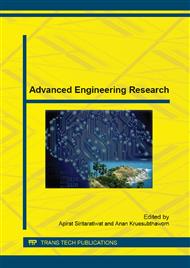p.454
p.458
p.462
p.466
p.471
p.475
p.479
p.483
p.487
Error Analysis of 4-Crossing Hall Sensor with Frequency Domain in Measurement of Material Imperfection
Abstract:
This study presents a methodology of frequency domain for analysis the output signal of the sensor device in order to enhancing the performance and resolution in measurement of a sensor module. However, in this case used the new sensor module namely 4-crossing Hall sensor, which was designed by the assembling of four permanent magnets with four Hall generators as a sensor device. An analysis of frequency domain in this study aims to develop a new non-destructive measurement using a new sensor module as a sensor device in order to measure the imperfection of metal materials using, in some cases, the methodology of non-destructive inspection. This process was performed by transforming the values in the pattern of the output voltage from sensor device, which was amplified by the instrumentation amplifier into the time domain by the voltage to frequency converter and then transformed into the frequency domain based on the principle of Fourier transform. It was found that an analysis by frequency domain is the methodology which can be explicitly applied to detect the dimension of holes on a metal surface. In an experiment, the principle of frequency domain can precisely determine and distinguish the depth of drilled holes with 1 mm difference.
Info:
Periodical:
Pages:
471-474
Citation:
Online since:
August 2015
Authors:
Keywords:
Price:
Сopyright:
© 2015 Trans Tech Publications Ltd. All Rights Reserved
Share:
Citation:


